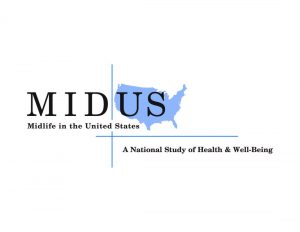Midlife in the United States renewal continues cutting-edge research into health and well-being
By Natasha Kassulke, natasha.kassulke@wisc.edu
Childhood and older age have been, and continue to be, studied extensively. But the wide terrain known as midlife – the longest segment of the life course – had been largely uncharted until creation of the Midlife in the United States (MIDUS) study in 1995.
For the past two decades, MIDUS has been led by the UW-Madison Institute on Aging, which recently received a six-year, $62M renewal of this national longitudinal study from the https://www.nia.nih.gov/. The funds will ensure that mid-life will continue to be prominent in national research about health. The new work will also be expanded to explore more ways for people to keep healthy even in the face of adversity, such as hardships related to the COVID-19 pandemic.
For example, that having a sense of purpose in life is associated with better health and living longer and that cognitive decline is not inevitable.
Looking ahead, MIDUS researchers hope to build on past findings with an eye toward studying how differences in emotional responses are associated with the ability to cope with the long-term stress, including personal impacts of the pandemic, social inequality and racial injustice.
“During our prior funding, we carefully assessed hardships of the Great Recession to learn for whom these were most prevalent and how they mattered for physical and mental health,” explains Carol Ryff, director of the Institute on Aging and principal investigator for MIDUS. “Going forward, we will assess long-term hardships of the pandemic and for whom these are most prevalent. A guiding hypothesis is that those who experienced the greatest pandemic hardships are Americans who were already vulnerable – low socioeconomic status, racial minorities, those with high hardships from the Recession. The core idea is thus that of cumulative disadvantage that is piling up for some across this country and it likely will have adverse consequences for health.”
What makes MIDUS unique is the multidisciplinary perspective it brings, Ryff adds.
“We bring together psychosocial, social, biological and neuroscience domains to gain a deeper understanding who stays healthy as they age and who does not,” Ryff says. “Our study has engaged scientists from all over the world – more than 26,000 people use our publicly available data. Together, their efforts have resulted in more than 1,800 publications across wide-ranging scientific fields. MIDUS also serves an important role in training the next generation of scientists – over 275 doctoral dissertations have completed using our data.”
In her own research, Ryff studies the positive side of well-being – that is, good mental health. She is interested in how qualities like purposeful life engagement, having good ties with family and friends, feeling able to manage one’s surrounding environment matter for important health behaviors such as sleep, exercise, and nutrition as well as for stress hormones and inflammatory markers.
“What we are learning is that the goals and objectives that give our lives meaning help us manage what is coming at us – MIDUS is thus an incredible resource for understanding human resilience,” she says.
MIDUS research is far-reaching and involves many scientists from around the United States, including many investigators from different departments on the UW–Madison campus.
“The MIDUS grant renewal means everything to me and my research team who are thrilled we can continue to work together on such an important study,” says Stacey M. Schaefer, principal investigator of the MIDUS Affective Neuroscience Project. “This next wave of data collection will provide the first follow-up of the MIDUS Refresher sample and the 4th follow-up of the MIDUS Core sample.”
With this new data, Schaefer’s team hopes to learn how the brain changes with aging and different life experiences, such as the personal impacts of the COVID-19 pandemic, and what factors may protect against some age- or stress-related changes.
“This data collection will be the first longitudinal psychophysiological and neuroimaging assessments of emotional responses in people into their 90s and possibly 100s!” Schaefer says. “These data, when combined with the breadth of sociodemographic, psychosocial, and lifestyle information in MIDUS will allow us to expand our understanding of the factors that contribute to emotional wellbeing, how emotional processes contribute to health in the body and in the brain, including brain aging processes, neurodegeneration, and the development of Alzheimer’s Disease and related diseases.”
Black Americans from Milwaukee comprise a third of the MIDUS Neuroscience Project participants and Schaefer says that their participation is crucial for learning how experiences of racial inequity and discrimination impact emotional wellbeing and brain aging, as well as the factors that promote resilience even in the face of adversity.
“This grant renewal has been a long time coming and required a great deal of sweat and tears from the many MIDUS investigators and their research teams,” Schaefer says. “Through it all, we have been incredibly fortunate to have Professor Ryff steer us successfully through the pandemic and the renewal. Without her leadership and perseverance, as well as the amazing contributions of the many people involved in MIDUS, we wouldn’t have this fantastic opportunity ahead.”
Sterling Johnson, professor of geriatrics and adult development in the Department of Medicine with affiliation at the Waisman Center an associate director of the Alzheimer’s Disease Research Center, echoes Schaefer’s praise for Ryff’s leadership and looks forward to research advances to come from the next phase of MIDUS research and his study into the relationship between emotion and preclinical Alzheimer’s Disease.
“MIDUS has been a groundbreaking study for many years under Professor Ryffs’ leadership,” Johnson says. “With this renewal and expansion of the project, we are forging more new ground. We will be able to study the rich life-histories of the MIDUS participants in relation to brain health. We will be peering into the brain with specialized brain scans to look for early signs of certain diseases of the aging brain including vascular disease and Alzheimer’s Disease. We will also be examining novel brain biomarkers that can be detected from a blood sample. “
Johnson notes that MIDUS is an extraordinary opportunity to see how a person’s lived experience in midlife impacts the brain.
More than 5 million adults in the United States live with Alzheimer’s Disease. In addition to the cognitive complaints in Alzheimer’s, this population also experiences high rates of depression, anxiety, agitation, irritation and mood swings. Yet, little is known about how emotions, such as the ability to regulate negative emotions, may be disrupted in Alzheimer’s.
“I feel very fortunate to join the MIDUS investigators in this meaningful work,” Johnson says. “I plan to bring the experience I have gleaned from leading the Wisconsin Registry for Alzheimer’s Prevention (or WRAP) and apply it here. We have found that Alzheimer’s brain changes start to happen a decade or two prior to symptoms and this is a potential window of opportunity for prevention.”
The first MIDUS national survey in 1995/96 was funded by the MacArthur Foundation Research Network on Successful Midlife Development. It was conceived by scientists from diverse fields who were interested in how physical and mental health changes across the decades of adult life, for whom, and why. To probe these questions, they surveyed over 7,000 Americans aged 25-74, asking for detailed information about people’s work and family lives as well as their views of themselves, their worries and concerns. MIDUS was innovative for the broad scope of its questions as well as its diverse samples (which included a national sample, siblings of many respondents, and a national twin sample).
Based on the success of MIDUS 1, the National Institute on Aging awarded a grant to the Institute on Aging, which is part of Office of the Vice Chancellor for Research and Graduate Education and School of Medicine and Public Health, to carry out a longitudinal follow-up of MIDUS respondents. Thanks to the quality and use of the MIDUS data, the study was extended to include cognitive assessments, biomarker and neuroscience assessments as well as recruitment of 600 African Americans from Milwaukee to sharpen the focus on racial disparities in health and well-being.
In 2011, MIDUS was again expanded to support recruitment of a new national sample, known as the “MIDUS Refresher”, as well as an additional sample of African Americans from Milwaukee – thus, adding more than 3,000 new participants to the study. A focus in this phase was to investigate how the Great Recession of 2008 affected the lives of American adults from change in employment status to loss of savings and homes, worries about paying bills, and changes in health insurance. It further explored how these experiences were linked to work and family life, emotional health and well-being, and biological risk factors.
“MIDUS is at the cutting edge in tracking the adverse health consequences of widening inequality in this country,” Ryff says. “And unlike many large epidemiological studies that focus on specific health outcomes such as cancer and heart disease, and related risk factors, MIDUS studies all varieties of health problems and gives far more attention to the surrounding historical context as well as psychosocial and behavioral factors. This is big picture science with big implications for preventing illness and promoting well-being with aging.”
###




